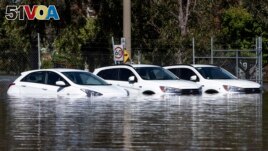23 October 2022
Scientists have long been predicting that global warming will increase extreme weather events around the world. Recent examples of such events are floods in Pakistan, extreme heat in Europe and drought in China, East Africa, northern Mexico, and the U.S. West.
"With just over one degree of warming since pre-industrial times, we are already seeing more extreme weather patterns," said Elizabeth Robinson. She is director of the Grantham Research Institute in London.
Kim Cobb is a climate scientist at Brown University in Rhode Island. She said researchers are now starting to get more exact details about the speed, size, and timing of climate changes. This includes details about how effects can be very different from region to region.

A trio of cars are stuck in floodwaters in Shepparton, Australia, Monday, Oct. 17, 2022. A flood emergency continues across parts of Australia's southeast. (Diego Fedele/AAP Image via AP)
Scientists usually compare the average global temperature today to estimates for the pre-industrial period. That is when the burning of fossil fuels first started to increase.
The average global temperature has increased between 0.9 and 1.2 degrees Celsius since 1850, mostly because of human activity. Those numbers come from estimates in the most recent report by the Intergovernmental Panel on Climate Change, or IPCC. Most of that warming has happened since 1975, at a rate of 0.15 Celsius to 0.2 Celsius per decade.
The average temperature in 2021 was 1.3 degrees higher than the 20th century average.
But most people are living in places where the temperature has increased more than the global average. That is because more and more people are living in urban areas. These areas can trap heat because of the many roads and buildings and because they have fewer trees. Trees help make an area cooler.
Climate and global temperatures have changed throughout the Earth's history. But it is the speed of recent changes that worries researchers.
Adapting to dangerous weather events is one big way humans can limit damage from climate change. Weather-related disaster deaths are generally going down in number globally. That is because weather predictions have improved and because people are more prepared, scientists say.
Robinson, the Grantham Research Institute scientist, said, "The extent to which people are harmed by an extreme weather event is strongly influenced by government policies."
She added that "there are limits to adaptation."
I'm Andrew Smith.
Seth Borenstein reported this story for the Associated Press. Andrew Smith adapted it for VOA Learning English.
_______________________________________________________________________
Words in This Story
drought –n. an extended period of time of drier than normal conditions in an area
region –n. a geographic area
fossil fuels –n. carbon-based sources of energy such as oil, coal, and natural gas
adapt –v. change behavior or ideas in response to a new or different situation
extent -n. the amount of, how much of